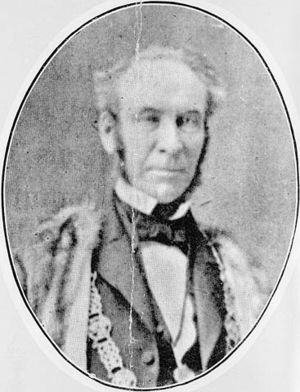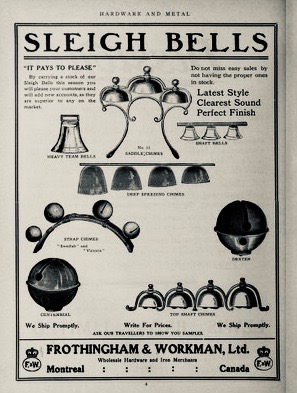| Preceded by Henry Starnes |
Mayor of Montréal/Maire de Montréal 1868 to 1871 |
Succeeded by Charles-Joseph Coursol |
Biography
Son of Joseph Workman 1749-1848 and Catherine Gowdey 1769-1871
William Workman was an Irish-Canadian businessman, and mayor of Montreal. According to the Dominion Annual Register and Review of 1878 he arrived in Canada in 1829, ten years after his brother Benjamin.
William started as a sub-editor of the Canadian Courant paper and then worked for J.&J.M. Frothingham which turned into a partnership in Frothingham & Workman.
Among his many accomplishments were serving three years as the Mayor of Montreal (1868 to 1870), President of the City & District Bank (1872 - 1878), and President of the City Bank (1849 - 1873).
William Workman was an Irish-born Canadian entrepreneur, businessman and philanthropist. He was a partner in Canada's largest wholesale house of Frothingham & Workman, and President of Montreal's City Bank. He was Mayor of Montreal (1868-1871) and invested in railways, shipping, real estate and charity.
He was a son of Joseph Workman of Ballymacash, and his wife Catherine Gowdey, daughter of Alexander Gowdey. In 1787 his father emigrated with a brother, Benjamin, to North America. [1]Benjamin Workman secured the position of Professor of Mathematics at the University of Pennsylvania and Joseph Workman worked under him as a tutor of mathematics. Joseph Workman left Philadelphia in 1790 and sailed to London with the aim of improvement to the mariner's compass, invented by Benjamin Workman, but only to find the mechanic, who had made some parts, had fraudulently patented it as his own. Returning to Ballymacash, he was appointed to the new schoolmaster where he met Catherine Gowdey, his student, who became his future wife. Joseph Workman replaced his father-in-law as land steward and he was appointed clerk of the peace.
William Workman grew up in Ballymacash and mastered the skills for employment with the Ordnance Survey of Ireland from 1827 to 1829 when his parents took him to Montreal to join his brothers, the eldest of whom had emigrated in 1819.
William Workman's first employment was working on newspapers, owned by his brother, Benjamin Workman. In 1830, he joined another brother, Thomas Workman, in the wholesale hardware of John Frothingham. By 1836 the Workman brothers had become full partners, indicating that they had brought some capital into the firm. As well as handling imported items, Frothingham and Workman manufactured some hardware in their Montreal factories which employed hundreds of men. William Workman would remain in partnership with Frothingham until his retirement in 1859, and under them it would become Canada's largest tool and hardware wholesale business.
William Workman invested in Canada's first railway, the Champlain and St. Lawrence, completed in 1836 and serving as a director. He was one of the largest shareholders in the St. Lawrence and Atlantic Railroad when the line was taken over by the Grand Trunk Railway in 1854. By the 1840's, William Workman was a wealthy man. In 1842 he built an impressive mansion in Montreal's Golden Square Mile which he named "Mount Prospect". He had considerable property elsewhere in Montreal, particularly on the western outskirts. From 1849 to 1874 he served as President of Montreal's City Bank. In 1854 he ventured into shipping with several prominent Montreal businessmen and was involved in establishing the Canadian Ocean Steam Navigation Company. A year later, William Workman purchased two large steamboats for the St. Lawrence trade.
Although business was clearly William Workman's major concern for many years, after his retirement from Frothingham and Workman in 1859, he took an active interest in public affairs. As a banker, he combated the government's proposed measures to widen its fiscal powers during the late 1860's. In 1866, he attacked Alexander Tilloch Galt's recommendations for tariff reductions, "these wild Balaklava dashes at fiscal legislation" would entail "beggary or emigration" for many Canadians. As a manufacturer, William Workman had favored high protective tariffs since the late 1840's when he led the Association for the Promotion of Canadian Industry. He made no known attempts to enter provincial politics but took an interest in federal affairs after confederation. During the 1870's, perhaps goaded by his brother Thomas' attachment to the Liberals, who, in William's view, were scented with a "spice or Communism," William Workman wrote occasionally to John A. MacDonald reminding him of his loyalty and contributions of "the ready" to the party. The letters were little more than importunate pleas for a Senate seat.
William Workman was known in Montreal for his municipal political activity and his local philanthropy. He was nominated for Mayor in February 1868 and ran against Jean-Louis Beaudry, a former incumbent. William Workman won the contest easily after overcoming disqualification and serious allegations of corruption levelled against him by his opponent. So popular was he as Montreal's Mayor, that he was returned to the post by acclamation in 1869 and 1870.
William Workman was a well-known local figure before he became mayor. Many years earlier, he had been president of the St. Patrick's Society before it became an exclusively Roman Catholic organization in 1856. Transferring his deep concern for the welfare of the less fortunate to the Irish Protestant Benevolent Society, William Workman served it for years, giving money and time to its causes. He helped to establish the Montreal Protestant House of Industry and Refuge in 1864; he serve as its president from 1874-1877 and left the institution a legacy of $20,000. To encourage thrift and saving among the city's workingmen, William Workman helped to found the Montreal City and District Savings Bank in 1846. He was the bank's first president, 1846-1862, and a director, 1861-1872.
William Workman's private life was touched with sorrow. Six children predeceased him and the loss of his son William, at age 24, was especially painful. Throughout most of this adult life, Workman was an adherent of the Unitarian church; he once confided to a friend that, as Unitarian, he was "accustomed to vituperation from opposing Protestant sects (never Roman Catholics)." According to one source, he later found solace in Roman Catholicism. He turned increasingly to private worship and had a family chapel added to his large mansion. Credit for the above article - G. Tulchinsky
William Workman was greatly affected by the loss of so many of his children. He had been an adherent of the Unitarian Church, but according to one source he later found solace in Roman Catholicism. He turned increasingly to private worship and had a family chapel added to his mansion house. After he died, his wife Elizabeth retired to Ocean House, Cape Elizabeth, Maine (which may have been her childhood home), where she died. All of the Workman family are buried together at Mount Royal Cemetery.
Find A Grave: Memorial #108978599 William Workman
Children
Elizabeth Workman 1831–1832
Louise Frothingham Workman Baker 1834–1890
Emma Workman 1837–1839
William Workman 1840–1865
Eliza Workman Moat 1843–1871
Malvina Workman 1845–1847
NOTE: A son, William Workman (May 1836-December 10,1838) Death is recorded in the Drouin Collection and gives his age as 18 months. That would mean birth about May of 1837 which won't work due to sister Emma's birth three months later, his estimated birth year as 1836. His name doesn't appear on the family monument stone, despite the fact that the other children who died very young have their names and dates on the family monument stone.
Sources
- "Canada Census, 1871," database, FamilySearch (https://www.familysearch.org/ark:/61903/1:1:M4KP-38M : 19 March 2021), William Workman, Montreal, Quebec, Canada; citing 1871; citing National Archives of Canada, Ottawa, Ontario.
- http://www2.ville.montreal.qc.ca/archives/democratie/democratie_en/expo/maires/workman/index.shtm
- http://www.lisburn.com/history/digger/Digger-2011/digger-19-08-2011.html
- G. Tulchinsky, “WORKMAN, WILLIAM,” in Dictionary of Canadian Biography, vol. 10, University of Toronto/Université Laval, 2003–, accessed May 20, 2014, http://www.biographi.ca/en/bio/workman_william_10E.html.
See also:
- Wikidata: Item Q3569040

- Obituary in The Dominion Annual Register and Review 1878 page 373
https://books.google.ca/books?id=GD8TAAAAYAAJ&printsec=frontcover
No known carriers of William's DNA have taken a DNA test.
Have you taken a DNA test? If so, login to add it. If not, see our friends at Ancestry DNA.
Featured Female Poet connections: William is 14 degrees from Anne Bradstreet, 23 degrees from Ruth Niland, 27 degrees from Karin Boye, 29 degrees from 照 松平, 16 degrees from Anne Barnard, 37 degrees from Lola Rodríguez de Tió, 20 degrees from Christina Rossetti, 17 degrees from Emily Dickinson, 32 degrees from Nikki Giovanni, 21 degrees from Isabella Crawford, 24 degrees from Mary Gilmore and 16 degrees from Elizabeth MacDonald on our single family tree. Login to find your connection.




Maria